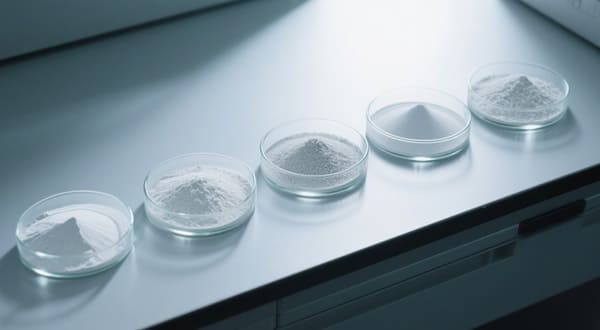Key Differences Between Alumina Grades: A Complete Comparison
Alumina (Al₂O₃) is one of the most widely used advanced ceramic materials across industries like electronics, aerospace, biomedical, and metallurgy. However, alumina is not a single material but comes in various grades that differ mainly by purity level, particle size, mechanical properties, and suitability for different applications. Understanding the key differences between alumina grades is crucial for engineers, designers, and procurement professionals to select the right material that meets performance and cost requirements. This article provides a comprehensive comparison of common alumina grades ranging from 95% to 99.95% purity, highlighting their characteristics, mechanical and thermal properties, applications, cost considerations, and how to choose the right grade for your needs. By the end, readers will be equipped to make informed decisions tailored to specific project needs.
At Advanced Ceramic Hub, we specialize in high-quality alumina ceramic products, ensuring optimal performance for industrial and scientific applications.

What Are the Typical Alumina Grades and How Are They Classified?
Alumina grades are typically classified by their chemical purity, which significantly influences their microstructure and performance. The most common grades range from industrial-grade (95%) to ultra-high purity (99.95%). Each grade corresponds to different impurity levels, mainly silica, iron, and alkali metals, which affect strength, electrical properties, and thermal resistance.
| Alumina Grade | Purity (%) | Typical Impurities | Common Forms |
| Al₂O₃-99.95% | 99.95 | <0.05% (trace elements) | High-purity powder, substrates |
| Al₂O₃-99.7% | 99.7 | ~0.3% | Fine powders, technical ceramics |
| Al₂O₃-99.5% | 99.5 | ~0.5% | Engineering ceramics |
| Al₂O₃-99% | 99 | ~1% | General purpose ceramics |
| Al₂O₃-96% | 96 | ~4% | Industrial grade, a brasives |
| Al₂O₃-95% | 95 | ~5% | Low-cost, structural ceramics |
Understanding these classifications helps to anticipate the trade-offs between cost and performance for each alumina grade.
Explore our high-quality alumina ceramic products.
How Do Mechanical Properties Vary Among Different Alumina Grades?
Mechanical strength, hardness, and fracture toughness vary notably across alumina grades due to differences in purity and microstructure. Higher purity grades generally deliver superior mechanical properties critical for load-bearing and wear-resistant applications.
| Alumina Grade | Flexural Strength (MPa) | Hardness (GPa) | Fracture Toughness (MPa·m½) |
| 99.95% | 420 | 20 | 3.5 |
| 99.7% | 400 | 19 | 3.3 |
| 99.5% | 350 | 18 | 3.0 |
| 99% | 300 | 16 | 2.8 |
| 96% | 250 | 14 | 2.5 |
| 95% | 220 | 13 | 2.3 |
Higher purity alumina grades possess fewer impurities that weaken grain boundaries, resulting in improved resistance to cracking and wear.
How Do Thermal Properties Differ Between Alumina Grades?
Thermal conductivity and thermal expansion coefficients are key factors for applications involving high temperatures or thermal cycling. Purity level affects these thermal properties by influencing grain boundary phases and defects.
| Alumina Grade | Thermal Conductivity (W/m·K) | Coefficient of Thermal Expansion (10⁻⁶/K) |
| 99.95% | 30–35 | 7.0–7.5 |
| 99.7% | 28–33 | 7.0–7.5 |
| 99.5% | 25–30 | 7.5–8.0 |
| 99% | 22–27 | 7.5–8.5 |
| 96% | 20–25 | 8.0–8.5 |
| 95% | 18–23 | 8.5–9.0 |
High-purity alumina is preferred for thermal management components, whereas lower grades suffice for less demanding thermal applications.
What Are the Typical Applications of Different Alumina Grades?
The distinct characteristics of alumina grades determine their suitability for various applications. High purity grades find use in high-tech and demanding fields, while lower purity grades serve in industrial and structural roles.
| Alumina Grade | Common Applications |
| 99.95% | Semiconductor substrates, LED wafers, microelectronics |
| 99.7% | Precision ceramic parts, cutting tools |
| 99.5% | Electrical insulators, wear parts, biomedical implants |
| 99% | General ceramics, industrial components |
| 96% | Abrasives, kiln furniture, furnace linings |
| 95% | Structural ceramics, refractory linings |
Choosing the appropriate grade optimizes cost without compromising performance in specific use cases.
How Does Cost Influence the Choice of Alumina Grades?
Cost is a significant factor when selecting alumina grades. As purity increases, processing becomes more complex and expensive due to the need for high-quality raw materials and stringent manufacturing controls.
| Alumina Grade | Approximate Cost ($/kg) | Cost Factor Compared to 95% Grade |
| 99.95% | 150–200 | 6–8x |
| 99.7% | 100–130 | 4–6x |
| 99.5% | 70–90 | 3–4x |
| 99% | 40–60 | 2–3x |
| 96% | 20–30 | 1.5–2x |
| 95% | 15–20 | 1x |
Balancing cost against performance requirements is essential for efficient project budgeting and sourcing.
How Do Alumina Grades Impact Manufacturing Processes?
Different alumina grades require tailored manufacturing approaches to optimize their microstructure and properties. Higher purity powders demand more precise sintering conditions to achieve full densification and uniform grain growth.
| Alumina Grade | Typical Sintering Temperature (°C) | Common Processing Methods |
| 99.95% | 1650–1750 | Hot isostatic pressing, spark plasma sintering |
| 99.7% | 1600–1700 | Pressureless sintering, HIP |
| 99.5% | 1550–1650 | Conventional sintering |
| 99% | 1500–1600 | Pressureless sintering |
| 96% | 1450–1550 | Conventional sintering |
| 95% | 1400–1500 | Basic sintering |
Manufacturers optimize parameters to improve density and mechanical integrity according to grade specifications.
How Do Alumina Compare to Other Ceramic Materials?
To put alumina’s properties into perspective, comparing it with other common ceramic materials like zirconia, silicon carbide (SiC), and silicon nitride (Si₃N₄) can help identify the best choice for specific applications.
| Material | Flexural Strength (MPa) | Hardness (GPa) | Fracture Toughness (MPa·m½) | Thermal Conductivity (W/m·K) |
| Alumina (99.5%) | 350 | 18 | 3.0 | 25–30 |
| Zirconia (3Y-TZP) | 1000 | 12 | 8.0 | 2–3 |
| Silicon Carbide | 400 | 25 | 3.5 | 120–150 |
| Silicon Nitride | 700 | 16 | 7.0 | 20–30 |
Alumina offers a good balance of hardness, thermal conductivity, and moderate toughness. Zirconia provides superior toughness but lower thermal conductivity, while SiC excels in hardness and thermal conductivity but can be more expensive.
How to Choose the Right Alumina Grade for Different Applications?
Selecting the optimal alumina grade depends on balancing purity, mechanical properties, thermal requirements, cost, and manufacturing capabilities. Here is a simplified guide:
| Application Type | Cost-sensitive, less stringent purity | Key Considerations |
| Electronics & Microelectronics | 99.7% – 99.95% | High purity, low impurities, tight specs |
| Biomedical Implants | 99.5% | Biocompatibility, wear resistance |
| Industrial & Mechanical Parts | 99% – 99.5% | Good mechanical strength, cost-effective |
| Abrasives & Kiln Furniture | 95% – 96% | Cost sensitive, less stringent purity |
| Structural Ceramics | 95% | Basic mechanical requirements, low cost |
Understanding the requirements of the end-use environment will guide the choice toward the most cost-effective and performance-optimized alumina grade.
Request a custom quote for alumina ceramic products.
What Are the Emerging Trends in Alumina Grades and Their Applications?
Continuous innovation is pushing alumina grades towards finer particle sizes, higher purity, and composite formulations to enhance performance for cutting-edge applications such as quantum computing, advanced sensors, and bioimplants.
- Nano-sized alumina powders improve sintering and mechanical strength.
- Composite alumina-ceramic hybrids combine toughness and hardness.
- Tailored dopants improve electrical or optical properties.
- Sustainable manufacturing techniques reduce energy consumption.
These advancements promise broader application scopes and better property customization.
FAQ
| Question | Answer |
| What is the main difference between alumina grades? | Purity level and impurity content primarily differentiate them. |
| Can lower-grade alumina be used in electronics? | Generally not recommended due to higher impurities affecting performance. |
| Is higher purity always better? | Higher purity offers better properties but at increased cost. |
| How do impurities affect alumina? | They weaken grain boundaries, reduce strength, and lower thermal stability. |
| Are alumina grades interchangeable? | No, each grade suits specific applications and performance requirements. |
Conclusion
Selecting the right alumina grade involves understanding the trade-offs between purity, mechanical and thermal properties, manufacturing processes, application requirements, and budget constraints. High-purity alumina grades (99.5% and above) excel in demanding fields like electronics and aerospace, while lower grades fulfill industrial, abrasive, and structural needs at a lower cost. Staying informed about emerging alumina materials and technologies enables engineers and purchasing professionals to make strategic decisions that optimize performance and cost-efficiency. Whether designing cutting-edge components or bulk industrial parts, knowing the key differences between alumina grades is indispensable for success.
Looking for high-quality alumina ceramic products? Contact us today!
